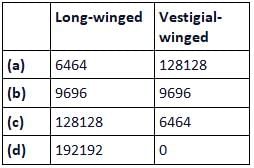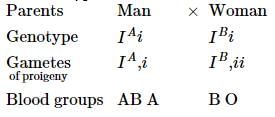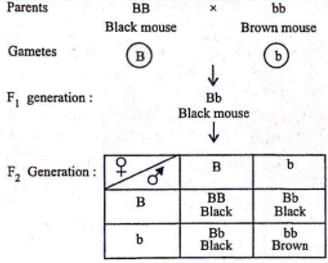Test: Inheritance of One Gene (NCERT) - NEET MCQ
20 Questions MCQ Test - Test: Inheritance of One Gene (NCERT)
In Antirrhinum (dog flower), phenotypic ratio in F2 generation for the inheritance of flower colour would be
To determie the genotype of a tall plant of F(2) generation, Mendel crossed this plant with a dwarf plant. This cross represents a
Genes which code for a pair of contrasting traits are known as
If four o'clock plants, the gene for red flower colour (R) is incompletely dominant over the gene for white flower colour (r), hence the plants heterozygous for flower colour (Rr) have pink flower. What will be the ratio of offsprings in a cross between the red flowers and pink flowers?
What will be the distribution of phenotypic features in the first filial generation after a cross between a homozygous female and a heterozygous male for a single locus?
A child has blood group O. If the father has blood group A and mother blood group B, work out the genotypes of the parents
Complete the given table showing different possililities of genotypes and their corresponding blood group, by selecting the correct option

What is the probability of production of dwarf offsprings in a cross between two heterozygous tall pea plants?
Inheritance of roan coat in cattle is an example of
If both parents are carriers for thalassaemia, which is an autosomal recessive disorder, what are the chances of pregnancy resulting in an affected child?
An allele is said to be recessive, when it is expressed in
The characters which appear in the first filial generation are called
A tobacco plant heterozygous for a recessive character is self-pollinated and 1200 seeds are subsequently germinated. Flow many seedlings would have the parental genotype?
Which of the following cross will give tall and dwarf pea plants in same proportions?
In mice, Y is the dominant allele for yellow fur and y is the recessive allele for grey fur. Since Y is lethal when homozygous, the result of cross Yy x Yy will be
Andalusian fowls have two pure forms — black and white. If black forms (BB) and white forms (WW) are crossed, F1 individuals appear blue coloured (BW), due to incomplete dominance. Which of the following would be an outcome of a cross between black form and blue form?
In mice, black coat colour (allele B) is dominant to brown coat colour (allele b). The offspring of a cross between a black mouse (BB) and a brown mouse (bb) were allowed to interbreed. What percentage of the progeny would have black coats?
Read the given statements and select the correct option
Statement 1: The law of segregation is one of the most important contributions to the biology
Statement 2: It introduced the concept of heredity factors as discrete physical entities which do not become blended.
In fruit flies, the long wing is dominant to the vestigial wing. When heterozygous long-winged flies were crossed with vestigial-winged flies, 192 offsprings were produced. Of these, 101 had long wings and 91 had vestigial wings. If an exact Mendelian ratio had been obtained, then the number of each phenotype would have been

What can be the blood group of offspring when both parents have AB blood group?

























